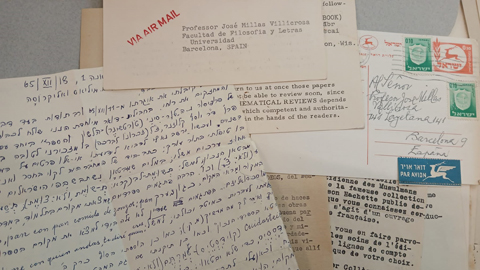The science of al-Andalus, now closer thanks to the creation of the digital collection Millàs
The UAB has created the digital collection of works owned by Arabist and al-Andalus scholar Josep M. Millàs Vallicrosa. Deposited at the UAB for years, 145 documents (notes, letters, handwritten notes, etc.) on Arabic science, scientific instruments, medieval Hebrew poetry, history of astronomy and mathematics, and historiography of science have now been digitised and uploaded to the Dipòsit Digital de Documents (DDD).

The collection of 75 letters in English, Spanish, French and Arabic between Millàs and Belgian historian George Sarton-promoter of the history of science in Europe and the United States-is one of the jewels of the collection.
Josep M. Millàs i Vallicrosa (Santa Coloma de Farners, 1897 - Barcelona, 1970) excelled in the study of the history of science in Muslim Spain and in the study of medieval Hebrew poetry. The school of Arabists and historians of science that he founded has never ceased to explore the science of al-Andalus with exemplary rigor.
The personal collection deposited in the Library of Science and Technology of the UAB includes documents on Arab science, scientific instruments, medieval Hebrew poetry, history of astronomy and mathematics, and historiography of science, as well as Millàs' personal collection, including correspondence and personal works.
Access to the digitised collection is open to everyone, since the documents digitised in this first phase by the UAB Library Service can be consulted in the DDD digital repository (access to the digitised part of the collection). They belong to the personal and professional correspondence, handwritten and mechanoscripted works in which stand out the drafts of articles, galley proofs with corrections, information about his participation in congresses, and finally documentation in Hebrew and analysis of epigraphy, of which he was a great scholar.
According to Professor Xavier Roqué, from the Institute of History of Science at the UAB, the correspondence between Millàs Vallicrosa and George Sarton, the Belgian historian who in 1913 founded the journal Isis (which was probably the most prestigious journal in the discipline and from 1924 the organ of the History of Science Society of the United States), occupies a preferential place in this personal collection. Sarton promoted the institutionalisation of the history of science, first in Europe and then in the United States, where, at Harvard University, he trained the first professionals in the discipline. Between 1929 and 1955, Sarton and Millàs exchanged 75 letters in English, Spanish, French and Arabic. Some of them have been included in the new Millàs digital collection at the UAB.
1,894 documents on Arabic science and medieval Hebrew poetry
The UAB's Millàs Fund was born in 2000, when the personal library of Josep Maria Millàs i Vallicrosa became part of the collections of monographs and journals of the History of Science section of the Science and Technology Library of the UAB and, to a lesser extent, of the collections of the Medicine and Humanities libraries of the UAB. It includes 1,894 monographs and offprints on Arabic science, scientific instruments, medieval Hebrew poetry, history of astronomy and mathematics and historiography of science; various series of periodicals (including 40 volumes of the journals Isis and Archives Internationales de Histoire des Sciences that complement the UAB collection), and the almost complete collection of the works of Josep Maria Millàs.
Apart from the enormous symbolic value of his personal collection (1901-1987), which includes 70 original letters, 49 works and 415 diverse documents, the works that make up the collection substantially expand the possibilities for research in history, philology and the history of science at the UAB.
The collection also contains the archive of Eduard Millàs i Vendrell (Barcelona, 1937-1999), son of Millàs i Vallicrosa and historian Francisca Vendrell i Gallostra. Eduard Millàs' archival collection consists of seven boxes containing more than seventy ring binders: notes and handwritten notes on primary texts on the history of ancient and medieval Arab astronomy, the preparation of published works and, above all, the university teaching of these subjects.
Another part of Josep M. Millàs' personal collection is located at the University of Barcelona, in the Philology and Communication CRAI Library.
What did al-Adalus represent?
The cultural legacy left by the Muslims of al-Andalus is broad and diverse. In addition to their well-known contribution to architecture and urban planning with the construction of impressive buildings and monuments such as the Mosque of Cordoba or the Alhambra Palace in Granada, they also excelled in the areas of science, philosophy, literature, poetry and medicine. They also played a fundamental role in the preservation, translation and commentary of scientific and literary works in both Greek and Latin, and are credited with advances in the manufacture of paper or the manipulation of matter (what would later become chemistry). Mathematics, geometry and astronomy are other fields in which they excelled.
From Pere Calders to José Agustín Goytisolo: the other collections at the UAB
In addition to Josep M. Millàs, among the personal collections of the UAB we find letters, manuscripts, monographs, journals, drawings and other documentary material of writers, poets, translators and scientists such as Pere Calders, José Agustín Goytisolo, Jordi Castellanos, Jesús Moncada or David Rosenthal, the filmmaker Ana Simon, Occitan language writer Bernard Lesfargues or biologist Josep Egozcue, among others. All of them have donated academic, professional and personal documentation to the UAB Library Service so that, once organised, systematised and, to a large extent, digitised, it can be made available to the public.
Online personal collection of Josep M. Millàs i Vallicrosa
The UAB, with Sustainable Development Goals
Quality education